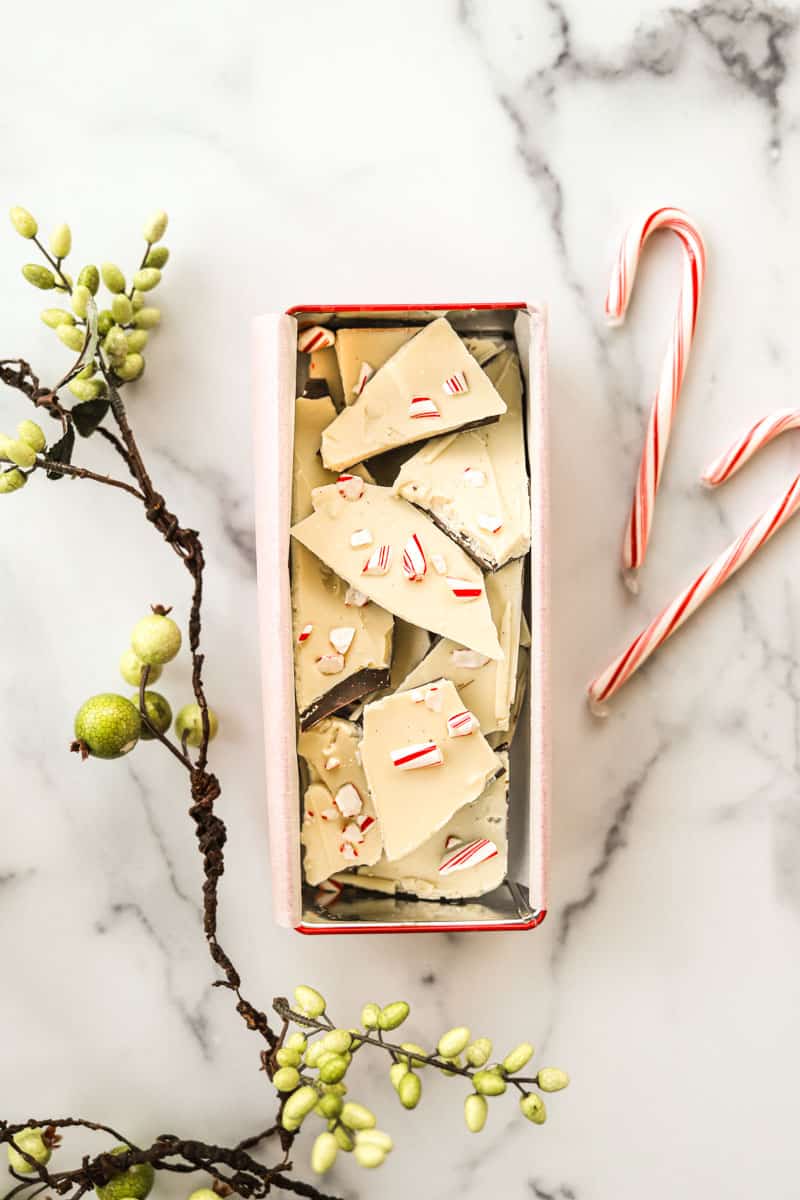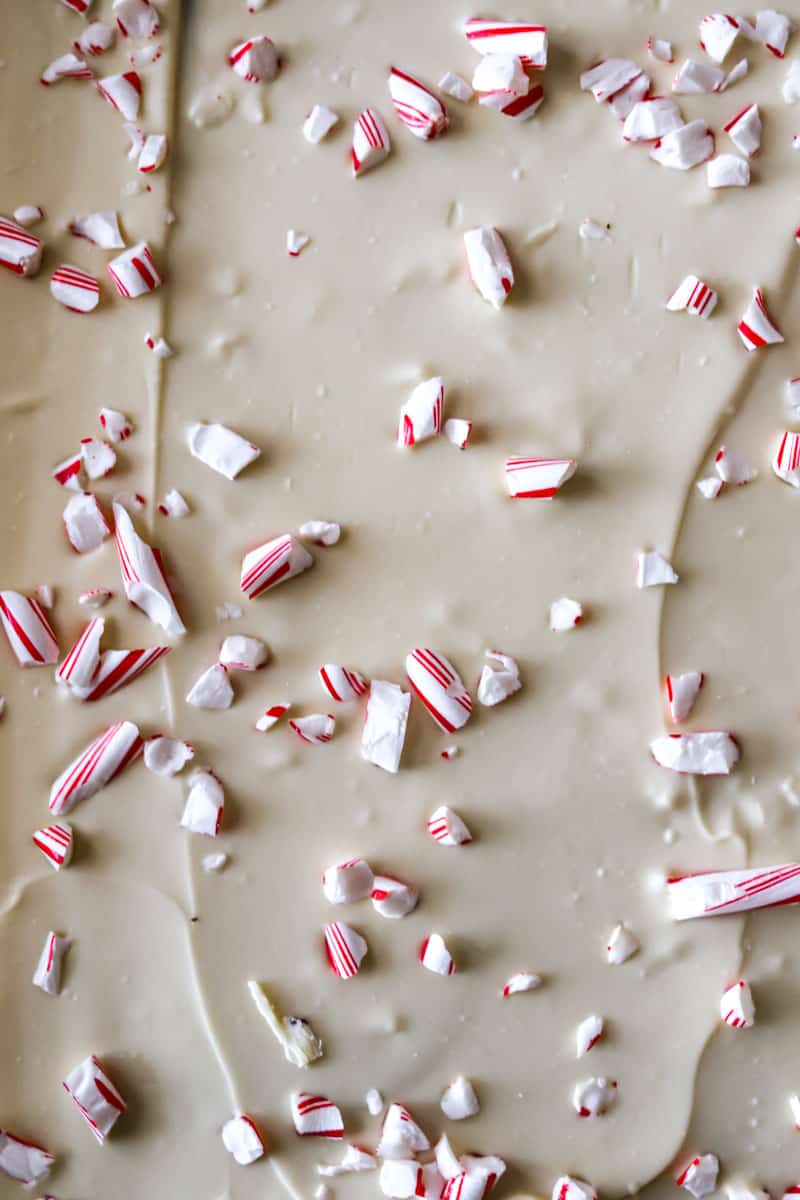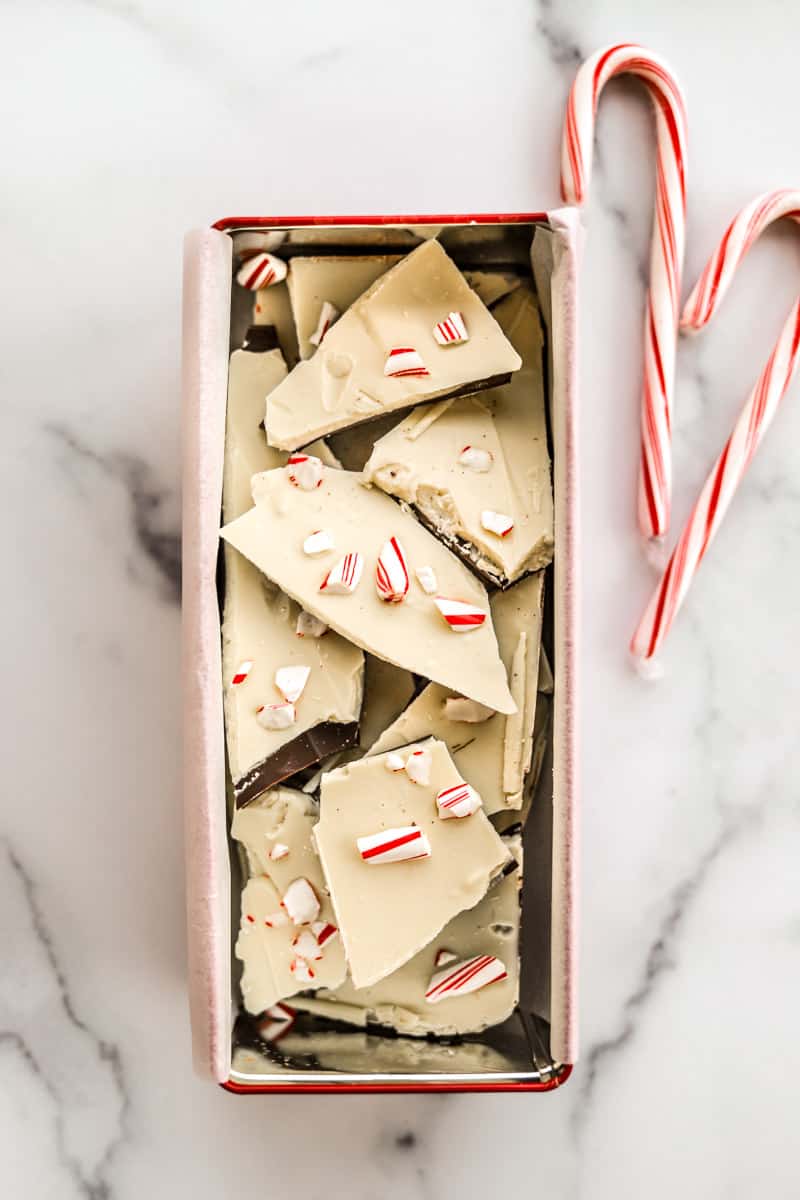Williams Sonoma makes the very best peppermint bark in the world. Don’t believe us? We took matters into our own hands just a few days ago and sampled the top 10 major brands of peppermint bark available nationwide in the U.S., side by side. And although there was a good variety of delicious bark, Williams Sonoma was the clear winner.
Video: Who Makes the Best Peppermint Bark?
What Makes The Williams Sonoma Peppermint Bark So Good?
There are a few things that make the Williams Sonoma Peppermint Bark absolutely addicting: 1) High-quality Guittard chocolate. Guittard actually makes a special blend of dark chocolate just for the Williams Sonoma Peppermint Bark and it is truly sublime. 2) Just the right amount of peppermint. So many peppermint barks are completely overkill when it comes to the peppermint oil combined with the chocolate, but we found that the Williams Sonoma bark has the perfect slight hint of mint. 3) Larger pieces of peppermint scattered randomly on the top layer of the bark, rather than coating the entire surface of the peppermint bark. It adds great texture and flavor, but again doesn’t completely take away from our favorite part of the bark– the chocolate.
The Best Ever Williams Sonoma Peppermint Bark Copycat Recipe
We trialed this recipe several times to perfect it, but finally nailed an identical bark that will cost significantly less and taste just as delicious. Most importantly you’ll need high-quality couverture chocolate (made with cocoa butter) for both the white and dark chocolate for this recipe. Make sure to avoid compound chocolate (typically made with vegetable oil), which won’t yield near as delicious of a result and requires completely different instructions for melting. You will need to temper your chocolate for this recipe, but thanks to our friends at Orson Gygi, they’ve made it incredibly easy for you to successfully temper chocolate, even if you’re a newbie.

How To Temper Chocolate (And Where To Buy It)
Following this recipe step by step will give you a delicious, beautiful end result, but if you want more information on tempering chocolate or would like to feel more confident going into the process we highly recommend checking out this blog post for a basic overview, or this IGTV for an awesome step-by-step demonstration. We purchased all of the chocolate for our Williams Sonoma Peppermint Bark recipe at Orson Gygi– they’re located in the Salt Lake Valley but if you’re not in Utah never fear, they ship! For this specific recipe we used the Guittard “French Vanilla” couverture dark chocolate and the Callebaut couverture white chocolate callets. If you’re purchasing elsewhere be sure that you’re using a couverture chocolate, which will have cocoa butter listed in the chocolate ingredients.

Peppermint Bark Tips & Tricks
A few things we learned along the way that will help you achieve a flawless peppermint bark:
- Use high-quality chocolate. Making your own peppermint bark takes time! If you’re going to all of the trouble and you really want it to taste like the Williams Sonoma peppermint bark, don’t skimp.
- Make this bark when you have time. Budget for an hour or so to make this recipe from beginning to finish. Each layer of chocolate will take about 30 minutes in total to temper, and you want your bark to sit at room temperature and set for about one hour before tasting or breaking into pieces.
- Start small with the peppermint oil and add more if needed. You can always add more peppermint oil if you feel like it needs it, but you can’t omit it from your chocolate once combined. We used LorAnn oils super-strength peppermint oil for this recipe and only needed 1/4 teaspoon for the entire batch.

My peppermint bark layers are separating. Help!
- First and foremost, only use high-quality, properly tempered chocolate.
- Do not refrigerate your chocolate layers. Let each layer harden at room temperature. Properly tempered chocolate firms up at room temperature with no problem, as long as your home isn’t running too warm.
- Once your peppermint bark has been completely set up, break into smaller pieces with clean hands. Using a knife can separate the dark and white chocolate layers.
Equipment Needed
- Instant Read Thermometer
- Silicone Bowls (optional but great for tempering chocolate)
- Bench Scraper (optional but great for creating even layers)
- Half-sheet baking pan
- Parchment paper (we like using these sheets)
- Food Scale (to weigh chocolate)
Make Next: Tupelo Honey Chocolate Pecan Pie
Williams Sonoma Peppermint Bark Copycat Recipe
Ingredients
- 2 pounds dark chocolate (couverture)*
- 2 pounds white chocolate (couverture)*
- 1/4 teaspoon peppermint oil**
- 6 peppermint candy canes
Instructions
- Prepare the candy cane pieces. Place the unwrapped candy canes in a gallon ziplock bag. With a mallot or another hard flat object (a can or the bottom of a glass works great), gently crush the candy canes into large pieces. Pour into a small bowl and gently shake the candy in the bowl until the larger pieces surface to the top. Set aside.
- Temper the dark chocolate. Place 2/3rds of the dark chocolate in a silicone or plastic bowl and microwave for no longer than 1-minute intervals, until the chocolate is melted and has reached between 115 and 120 °F. Be careful not to burn the chocolate, and stir between each interval. Add the remaining 1/3 of unmelted chocolate to the melted chocolate (this is your "seed") and stir together to help cool down the melted chocolate. Continue to stir until your chocolate reaches 89 °F. This may take some time. If you have additional pieces of chocolate in your bowl that have not melted once your chocolate reaches 89 °F, you may either remove the extra pieces of chocolate, or cool the chocolate to 78 °F and slowly warm the chocolate again, keeping it below 89 °F.
- Test your chocolate. Make sure that the tempering process was done correctly by dipping a small piece of parchment paper into your bowl of chocolate and gently setting on another piece of parchment paper for 2-3 minutes. After waiting a few minutes, your chocolate should not appear wet and have a good sheen on the surface. It should also appear set and have a proper snap. If the test is unsuccessful, start the tempering process from the beginning again. If your test is successful, proceed to the next step.
- Pour your dark chocolate. Line a standard half sheet pan with parchment paper. You can place two small dime-sized drops of chocolate on separate ends of the paper, and then place the chocolate side down to keep your parchment in place as you pour. Pour the dark chocolate into the lined half sheet pan and use a bench scraper to distribute the chocolate as evenly as possible across the half sheet pan. If you do not have a bench scraper you may use a spatula. Set aside at room temperature to harden. Do not put in the fridge.
- Temper the white chocolate. Place 2/3rds of the white chocolate in a silicone or plastic bowl and microwave at 1-minute intervals, until the chocolate is melted and has reached 110 °F. Be careful not to burn the chocolate, and stir between each interval. Add the remaining 1/3 of unmelted chocolate to the melted chocolate (this is your "seed") and stir together to help cool down the melted chocolate. Continue to stir until your chocolate reaches 84 °F. This may take some time. If you have additional pieces of chocolate in your bowl that have not melted once your chocolate reaches 84 °F, you may either remove the extra pieces of chocolate, or cool the chocolate to 78 °F and slowly warm the chocolate again, keeping it below 84 °F.
- Test your chocolate. Make sure that the tempering process was done correctly by dipping a small piece of parchment paper into your bowl of chocolate and gently setting on another piece of parchment paper for 2-3 minutes. After waiting a few minutes, your chocolate should not appear wet and have a good sheen on the surface. It should also appear set and have a proper snap. If the test is unsuccessful, start the tempering process from the beginning again. If your test is successful, proceed to the next step.
- Once your white chocolate has successfully been tempered, add the peppermint oil to the white chocolate and stir together.
- Pour your white chocolate onto the dark chocolate. Your dark chocolate should be set at this point. Use a bench scraper to distribute the white chocolate as evenly as possible over the dark chocolate. If you do not have a bench scraper you may use a spatula. Take the candy cane pieces and sprinkle on top of white chocolate. Gently press pieces into white chocolate slightly. Set aside the sheet pan at room temperature to harden. Do not put in the fridge.
- After the bark has sat at room temperature for an hour, using a protruding edge of parchment paper, carefully remove the chocolate from the sheet pan. If all of the parchment paper has been covered in chocolate, you can use the edge of your bench scraper or a metal spatula to loosen the edges and then remove. Break the peppermint bark into palm-sized pieces or smaller with your hands. The peppermint bark will keep at room temperature for several weeks.
Equipment
- Instant read thermometer
- Parchment paper
- Bench scraper (optional)
Notes
Did you make this recipe?
Tag @femalefoodie so we can see what you're cooking!

